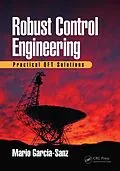This book thoroughly covers the fundamentals of the QFT robust control, as well as practical control solutions, for unstable, time-delay, non-minimum phase or distributed parameter systems, plants with large model uncertainty, high-performance specifications, nonlinear components, multi-input multi-output characteristics or asymmetric topologies. The reader will discover practical applications through a collection of fifty successful, real world case studies and projects, in which the author has been involved during the last twenty-five years, including commercial wind turbines, wastewater treatment plants, power systems, satellites with flexible appendages, spacecraft, large radio telescopes, and industrial manufacturing systems. Furthermore, the book presents problems and projects with the popular QFT Control Toolbox (QFTCT) for MATLAB, which was developed by the author.
Autorentext
Prof. Mario García-Sanz is one of the pioneers in the QFT robust control arena. Over the last 30 years, he has developed new QFT control theory for multi-input multi-output plants, distributed parameter systems, time-delay processes, nonlinear switching and feedforward control, including also methods to apply the Nyquist stability criterion in the Nichols chart, and to calculate QFT templates and bounds. In addition, he has designed many commercial control solutions for industry and space agencies. Customers include NASA-JPL, ESA-ESTEC, US-AFIT, NRAO-GBT, GMRT, Gamesa, Acciona, MTorres, IngeTeam, CENER, Eaton Corporation, Enercon, Siemens, Iberdrola, REE, Sener, EEQ, etc.
With over 20 industrial patents and 200 research papers, Dr. García-Sanz is one of the inventors of the TWT direct-drive variable-speed pitch-control multi-megawatt wind turbine, of the EAGLE airborne wind energy system, of the TWT variable-speed hydro-wind turbine, of the DeltaGrids optimal planning algorithms for electrical distribution networks, and of numerous advanced industrial controllers. In addition, he has been the Principal Investigator of over 50 funded research projects for industry, and worked as an international expert on wind turbine design and control in patent litigation at the British Court in London. As a Full Professor at the Public University of Navarra (Spain) and Senior Advisor for European wind energy companies, he played a central role in the design and field experimentation of multi-megawatt wind turbines for industry, including the advice of many PhD students and engineers in the field.
Dr. García-Sanz is currently a Professor and Founding Director of the Control and Energy Systems Center, and the inaugural Milton and Tamar Maltz Endowed Chair in Energy Innovation at Case Western Reserve University (http://cesc.case.edu). He also has been NATO/RTO Lecture Series Director for Advanced Controls, Visiting Professor at the Control Systems Centre, UMIST (UK); at Oxford University (UK); at the Jet Propulsion Laboratory NASA-JPL (California); and at the European Space Agency ESA-ESTEC (The Netherlands), and has given invited seminars in over 20 countries. He founded CoDyPower LLC, a consulting firm specialized on control systems, energy innovation and optimum planning of electrical distribution networks (http://codypower.com). Professor García-Sanz's CRC-Press three books "Quantitative Feedback Theory: Theory and Applications" (2006), "Wind Energy Systems: Control Engineering Design" (2012), and "Robust Control Engineering: Practical QFT Solutions" (2017) are among the best-selling books in QFT robust control and Wind turbine control. His QFT Control Toolbox for Matlab is considered as the top tool for designing QFT robust control systems. Dr. García-Sanz is Subject Editor of the International Journal of Robust and Nonlinear Control and was awarded the IEE Heaviside Prize (UK) in 1995, the BBVA research award (Spain) in 2001 and the CWRU Diekhoff Teaching Award (USA) in 2012 among other prizes.
Inhalt
Preface
Chapter 1. INTRODUCTION
1-1. The control engineer's leadership
1-2. QFT robust control engineering
1-3. Book's outline
1-4. Courses and modules
Chapter 2. QFT ROBUST CONTROL
2-1. Introduction
2-2. Plant modeling -Step 1
2-3. The nominal plant -Step 2
2-4. QFT-templates -Step 3
2-5. Stability specifications -Step 4
2-6. Performance specifications -Step 5
2-7. QFT-bounds -Steps 6 to 8
2-8. Controller design, G(s). Loop-shaping -Step 9
2-9. Prefilter design, F(s) -Step 10
2-10. Analysis and validation -Steps 11 to 13
2-11. Model matching
2-12. Feedforward control
2-13. P.I.D. control: design and tuning with QFT
2-14. Practical tips
2-15. Summary
2-16. Practice
Chapter 3. UNSTABLE SYSTEMS AND CONTROL SOLUTIONS
3-1. Introduction
3-2. Understanding gain/phase margins and Ws circles
3-3. The Nyquist stability criterion
3-4. Nyquist stability criterion in the Nichols chart
3-5. Examples
3-6. Guidelines to design controllers
3-7. Analysis of the first case
3-8. Summary
3-9. Practice
Chapter 4. TIME-DELAY AND NON-MINIMUM PHASE SYSTEMS
4-1. Time-delay systems
4-2. Robust design of the Smith Predictor
4-3. Continuing with Example 4.1
4-4. Non-minimum phase systems
4-5. Summary
4-6. Practice
Chapter 5. DISTRIBUTED PARAMETER SYSTEMS
5-1. Introduction
5-2. Modeling approaches for PDE
5-3. Generalized DPS control system structure
5-4. Extension of Quantitative Feedback Theory to DPS
5-5. Example 5.1: Heat conduction with distributed temperature
5-5. Summary
5-6. Practice
Chapter 6. GAIN SCHEDULING / SWITCHING CONTROL SOLUTIONS
6-1. Introduction
6-2. System stability under switching
6-3. Methodology
6-4. Examples
6-5. Summary
6-6. Practice
Chapter 7. NONLINEAR DYNAMIC CONTROL
7-1. Introduction
7-2. The circle stability criterion
7-3. Nonlinear dynamic control. One nonlinearity
7-4. Anti wind-up solution for PID controllers
7-5. Nonlinear dynamic control. Several nonlinearities
7-6. Summary
7-7. Practice
Chapter 8. MULTI-INPUT MULTI-OUTPUT SYSTEMS: ANALYSIS & CONTROL
8-1. Introduction
8-2. Formulation for n systems
8-3. MIMO systems - description and characteristics
8-4. MIMO QFT control -overview
8-5. Non-diagonal MIMO QFT. Method 1
8-6. Non-diagonal MIMO QFT. Method 2
8-7. Comparison of Methods 1 and 2
8-8. Heat exchanger, Example 8.1. MIMO QFT Method 1
8-9. Heat exchanger, Example 8.1. MIMO QFT Method 2
8-10. Summary
8-11. Practice
Chapter 9. CONTROL TOPOLOGIES
9-1. Introduction
9-2. Cascade control systems
9-3. Feedforward control systems
9-4. Override control systems
9-5. Ratio control systems
9-6. Mid-range control systems
9-7. Load-sharing control systems
9-8. Split-range control systems
9-9. Inferential control systems
9-10. Auctioneering control systems
9-11. Summary
9-12. Practice
Chapter 10. CONTROLLER IMPLEMENTATION
10-1. Introduction
10-2. Analog implementation
10-3. Digital implementation
10-4. Fragility analysis with QFT
10-5. Summary
10-6. Practice
Case study CS1. Satellite control
CS1-1. Description
CS1-2. Plant model
CS1-3. Preliminary analysis
CS1-4. Control specifications
CS1-5. Controller design
CS1-6. Analysis and validation
CS1-7. Summar…
